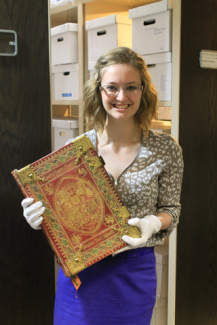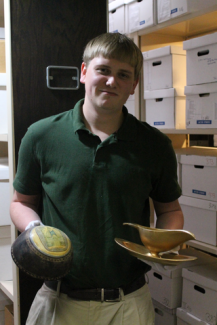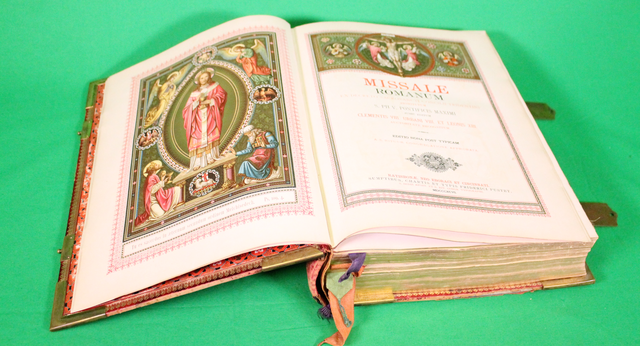In celebration of International Archives Day on June 9, recent Newman graduate Diana Stanley and sophomore Anthony Hamersky give an inside look into history that is worth acknowledging, along with some of their favorite archival memories.
NU: Can you tell us what year you are and what are your majors?
Stanley: I just graduated this spring semester with a bachelor of arts in history and minors in international studies, English and pre-law. I am the [Archives] Lead Student Intern, which means I deal with the budget, do more with exhibits as well as archive restructuring, and I did a lot of stuff to get us ready for the move.
Hamersky: I’m a history major and, quite simply, I do what she says and help out where I can. I work with processing, which involves taking a collection of raw archival material, deciding whether or not it fits in with what Archives already has or if it is something that is needed more of. I have also learned how to apply basic preservation techniques.
NU: How did each of you get involved with Archives here at Newman?
Stanley: While I was studying abroad in England, Sr. Charlotte Rohrbach, ASC, sent me a vague email saying to call her when I got back. When I went in and talked to her, she told me a little bit about Archives, and I thought, “Well, I am a history major, this could be a good fit.” I had already been working in a museum at this point, so I was familiar with what preservation is supposed to be, but it was a different role than what I had. I tried it out and liked it, and now I am still here two years later.
Hamersky: My experience was very similar. I got a call from Sr. Charlotte, which was very vague as well, and she told me, “This is Archives, this is what you will be doing.” I thought it would be enjoyable as a history major and I have survived a year so far.
NU: What are some of the benefits of working in Archives?
Stanley: You find things out about Newman all the time. I give a disclaimer in this intern training manual I just wrote that says, “The side effects of working in Archives, of prolonged exposure at least, may include: increased school pride, emotional attachment to dead people you have never met, a tendency to spout random Newman trivia facts, and extreme respect and admiration for the Adorers of the Blood of Christ.” That is something that you don’t necessarily expect to get out of when you first go into working in Archives, especially in that last bit. I certainly talk to Adorers all the time over at the convent, but this gives a different perspective.
NU: Any memorable finds?
Stanley: We had a bottle with a bunch of wax on it and seals on the side, and were trying to figure out what exactly it was but could not figure out the connection. We realized that in its original placement, it was right by a bunch of stuff from Sr. Sylvia Gorges, ASC. We had a day dedicated to her and how awesome she was, and we realized that in the midst of all this, there is a candle prayer and that the bottle is actually a candle — it’s this strange Irish spirits bottle filled with wax.
We recently found several books in the basement that were part of McNeill’s collection, which are in various states of needing preservation work on them. One of these books is the Roman Missal. I love it because it is beautiful on the outside, has a cool clasp on it and a bunch of very cool illustrations within.

NU: How has Archives changed since you first started?
Stanley: Well we moved, which took us about six months of preparation and a week of moving and reorganizing. Other than moving, not very obvious changes [have been made], but we did a few changes in structuring and how we entered things in archives to make it more effective. We went in with the library to focus more on photos, which can get a little tedious, but it has paid off in that people have asked us for photos of things and we have been able to just pull them up and not have to search. We have a long way to go in that, but if the short results mean anything, that will be done in the future.
NU: Do you have a favorite piece?
Stanley: That’s like choosing a favorite child — it’s impossible to choose just one. Although, I really liked the first basketball that was given to Sr. Sylvia and signed by all the basketball players.
Hamersky: My favorite new item would probably be these bowls from Brazil, three of which have Marian depictions on them. One depicts Our Lady at Lourdes, one from Fatima, and one has a Portuguese phrase on it that says, “Nossa Senhora de Nazare,” which is basically the title that the Brazilians gave her.
NU: How has working in Archives affected you?
Hamersky: Since I started working in Archives, I definitely have an increase of respect for the history of Newman and a lot of the ASC’s. Coming in, I had a minimal idea of the ASC and what they did, so the respect I have for them has grown tremendously. It has also increased my work ethic and my professional outtake at Newman, and it has helped a little with my writing as well.

Stanley: In my experience you don’t always realize that things have changed you until you are gone. I would say Archives feeds into many history projects I’ve done at Newman and has made me much better at exhibits. It also requires me to do a lot of thinking on my feet. It’s a day-to-day thing in Archives, because you have to make those decisions. You have to ask yourself, “Is this something we want to keep? Something we don’t? How am I going to preserve this?” It’s something that doesn’t really stop — it keeps coming throughout the day. And you have to make those decisions somewhat independently. You can ask people for help, and we certainly encourage it, but after a certain point you need to know what you are doing.
NU: Are there any individuals who specifically stand out to you?
Stanley: There are a lot of sisters who I think are rockstars because of what I have learned in Archives. You have people like Sr. Sylvia, who came in, had never been a president of a university, and had very little preparation for what it was. So she very smartly spends her first year going to a lot of conferences, going to a lot of meetings and listening to people about what a president needs to do. Then she spent the next nine years getting us an accreditation and building three or four buildings on campus. It’s people that might not have the know-how in the beginning, but know how to get the know-how, and then use it really effectively.
NU: Do you have any funny or memorable stories you would like to share?
Stanley: There was a reporter kidnapping. Back in the 80’s, Newman students decided that Newman was not getting enough fair coverage from the Wichita Eagle, so one of the students made an appointment with a reporter who agreed to meet with them. The reporter was thinking he was meeting with one or two people, so he was surprised when he came down to the lobby to see a crowd of rowdy college students. They promptly kidnapped him, put him in the back of the truck, and drove him to Newman. [Hamersky and Stanley laugh] They treated him well, though, and gave him food and whatnot.
The students then gave their personal tour of campus while explaining that they did not feel he was treating Newman appropriately and that he needed to give NU more newspaper coverage. So the students eventually took him back to the Eagle, where he wrote an editorial about how these college kids kidnapped him and he had the most wonderful time. And then, around the time he was retiring, that same reporter wrote an editorial saying that his most favorite news article was the editorial he wrote when a bunch of college students kidnapped him in the back of a pickup truck and drove him to Newman.
NU: What would you say to students, faculty and staff who haven’t visited Archives?
Hamersky: They definitely should. It’s Newman’s history, and with that come many stories, some of which are very interesting. For example, Fr. McNeill went around and asked for donations from families when the university first opened. There is also a lot on the athletics side that people don’t know about but would probably find interesting.
Stanley: We have a lot of resources, so if they are wanting to do some sort of project, we can help them out. One of our goals in the next five years is to increase student research, and [to be a] great potential for history students, music students, etc. The National Archives Movement has the idea of teaching education students to use more primary resources in their classrooms for social studies and beyond. We would love to see coordination of things like that, especially because learning how to research in archives helps you to research everywhere else. Come for the resources, stay for the stories.
We aren’t the only archives out there, so people should also look at their other community archives — there are a lot of them in the city. In my experience, archivists are generally very friendly people. I’ve known a lot of other friendly ones who want to help you.
NU: Any particular exhibits that Archives is working on?
Stanley: I am currently working on an exhibit that’s slowly coming together. It is all built around the school songs, like the fight song, various alma mater songs, various hymns, and songs that we attribute as “Newman-esque” — school pride things. This will be on exhibit in early June and will be up in the Heritage Room.

